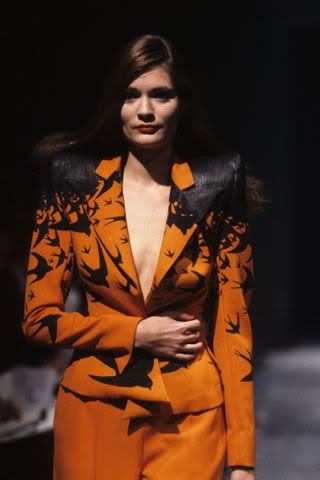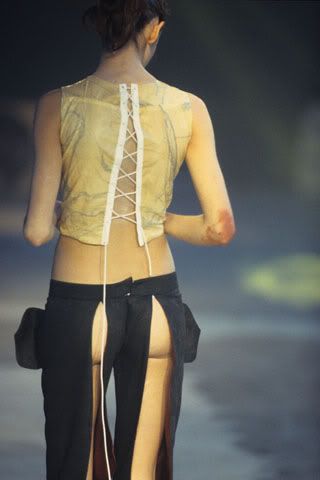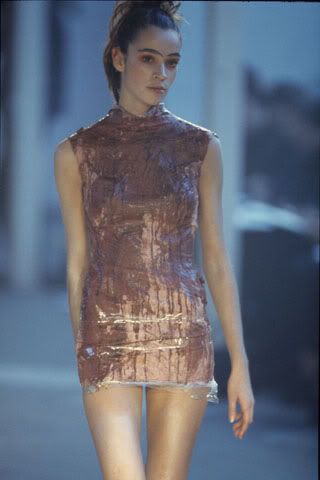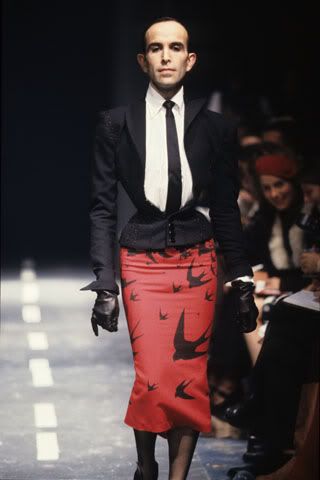@import url(https://www.blogger.com/static/v1/v-css/navbar/3334278262-classic.css);
div.b-mobile {display:none;}
My mum sent me this article from the Guardian this morning on London Fashion Week's 25th anniversary and I found it was so interesting I thought I would post the whole thing here for your reading pleasure. My heart belongs completely to British fashion, from all periods, and reading this article made me so homesick for London. I wish I could make it out to LFW, by far my favourite fashion week, but this time my boyfriend will have to wave the flag for me as he's going out there to dj a big party. Anyway, this article gives a good introduction into the highs and lows of British fashion over the last twenty-five years, and made me want to start counting the days till I can go home again... Oh, and just for your viewing pleasure I've added some photos from early collections by the enfant terrible of British fashion, Alexander McQueen.

Catwalk capital
by Sarah Mower
My induction to London Fashion Week took place sometime in 1986, at the hands of Lynne Franks. I say "hands" colloquially, but it was, more accurately, a full-body immersion. Lynne, London's superstar fashion PR of the "Designer Decade" (whose enthusiasms were only slightly exaggerated in Ab Fab's Edina), had decided that I, a rookie reporter who'd recently popped up on Fleet Street from Honey magazine, ought to be clued into what was going on at the first round of collections I was about to see. I accepted her invitation to lunch at the Sanctuary, an all-female urban spa in Covent Garden, but didn't realise it would literally be a naked one. Lynne was mid one of her health fads and had rolled the chore of meeting an upstart fashion editor into her latest regime of crudités and a lunchtime swim in the tiny pool (once used for a scene in The Stud). After nibbling a plate of carrots she threw off her towel and plunged in, keeping up a non-stop barrage of chat about Betty Jackson, Wendy Dagworthy, Katharine Hamnett, Jasper Conran and John Galliano, as I doggy-paddled along in her wake.
The reality of those days - the high 80s - when "the young London designer boom" was hitting its zenith, was at times beyond parody. Franks was, of course, the hype-mistress general, and it was all true about her changing six times a day to appear in her clients' latest looks while officiating at their shows. Back then it was touch-and-go as to whether you'd get into a Bodymap show, or whether your seat would turn out to be occupied by Boy George, in full frock and dreadlocks. One of my favourite shows was always Rifat Ozbek's. His gold-tasselled boleros and slinky pencil skirts gave us an exotic London parallel to Azzedine Alaia.
We, the attempting-to-be sophisticated young editors, would struggle through in our all-black uniforms - pencil skirts, opaque tights, flat lace-ups and removable shoulder pads Velcroed into black polo necks - trying to appear as soigne as Sade. Occasionally, after hours of vigorous note-taking about Vivienne Westwood's mini-crinis or Bruce Oldfield's cerise satin meringue ballgowns, a mysterious foam lump would emerge at your writing wrist, as a shoulderpad had worked itself free, presenting a dilemma about how to get it out without anyone noticing.
I haven't served quite the full 25 years of London Fashion Week under the organisation of the British Fashion Council, whose 1984 anniversary is about to be clocked up in the flurry of shows that commence on 18 September. I have been on the spot, though, when some of the most unforgettable fashion events of our times have been orchestrated - mind-blowing spectacles and searing social sub-commentaries magicked out of the kind of budgets international designers dedicate to sending flowers to celebrities. (Ratio-wise, there have been far more of the forgettable sort, of course, but a knack for editing out the duff bits is the first qualification for mental self-preservation in this game.)
London's collective genius has come in waves: Westwood-Hamnett-Galliano et al in the 80s; McQueen-Chalayan in the "Cool Britannia" 90s and, in the 00s, a new talent tsunami has surged, led by Christopher Kane, Marios Schwab and more. All of the ups and downs have been related to the peaks and troughs of the economy - as well as the convergence of competitive, often bolshie visionaries who've instigated changes in the way the whole world has wanted to dress. In the beginning, there was the combustion of "street style", documented by The Face and i-D, the appearance of a fashion-mad Princess of Wales, and the arrival in 1986 of the 37-year-old Anna Wintour in her first editorship at British Vogue (where she single-handedly brought in "short" by ordering her editors to cut skirt samples to 6in above the knee - a move that did not endear her to London's feminist rump of designers, who were thinking more "calf-length, tweed, Miss Marple" that season).
In the aftermath of the Black Monday stockmarket crash of 1987, things went quiet for fashion. But it was the British - more skint than anyone - who began to fire it all up again. Rave culture was stirring, creativity regenerating in squats, on zero money. Things were so down that, in 1992, London Fashion Week's exhibition was reduced to a few designers huddled together in rooms in the Ritz. It all seemed so hopeless till I was drawn along the corridor by the sound of squawking laughter. It was Isabella Blow, with a Philip Treacy feathered explosion on her head, corralling people towards a rack of razor-sharp tailoring, behind which was a bullet-craniumed cockney boy. It was Alexander McQueen and his first collection. The next "up" started there.



Three years on, McQueen was staging some of the most theatrical fashion events ever: Shalom Harlow spray-painted by machinery used for painting cars; a show on burning asphalt, another on ice. There was now an equally extraordinary showman in town, too. As the Bosnian war raged, Hussein Chalayan showed models stood in a sitting room clothed in furniture. When they exited, they left an empty home - like refugees. These experiences were the full goose-pimple deal; moments you knew you were privileged to experience. Was it a coincidence that Britart was also being born in the Royal Academy's "Sensation" show? Or that the Gallaghers and Damon Albarn were slugging it out for Britpop supremacy? It's hard to explain how these forces converged, but they did. Tony Blair tried to take ownership of it by inviting them all to Downing Street. McQueen went, reluctantly, but told me after, "Thought he was a tosser."
London wasn't all confrontational high-concept stuff in the 90s. We also had girly-boho, pretty cardigans and floral dresses set to become a world trend. There was Matthew Williamson, popping up in '97 with a brilliantly coloured first collection; Julien Macdonald's cobwebby designs, Clements Ribeiro pioneering what they called "clunky couture". It took another turn when Stella McCartney and Luella Bartley showed up with a fashion parallel to the Spice Girls' Girl Power. Their first "shows" were indistinguishable from drunken teen parties in their Notting Hill flats, where it was hard to make out if there were any clothes on offer.
Around the turn of the millennium there was another slump - the place was teeming with talent, and fashion conglomerates fought for acquisitions. McQueen and McCartney were signed by Gucci Group and started showing in Paris. Chalayan shifted there, too. Then history played its hand: 9/11 accelerated the drain of designers, as more decided that since Americans weren't travelling, they'd have to take their collections to New York. Luella, Matthew Williamson, Roland Mouret and Preen all went.
It was a wishy-washy phase I have trouble remembering. All I can be certain of is that it was in London that the first signs of confidence bubbled up again. In September 2006, on an outdoor catwalk in Holland Park, a kaleidoscope of bandage-and-synthetic lace dresses came streaming towards us with eye-popping conviction. Christopher Kane, who designed them, was hailed a star. I met him when he was still at Central Saint Martins, and discovered he had an encyclopedic knowledge of the work of Gianni Versace, gained watching satellite TV with his big sister Tammy as a child.
But Kane was far from the only talent in town. A new generation was in the offing, and one that was honed to produce clothes to professional standards that international stores recognised. "Body-con" was happening. A print revolution was taking place. Knitwear was taken into creative realms never seen before.
Erdem, Richard Nicoll, Louise Goldin, Meadham Kirchhoff, Mary Katrantzou, Mark Fast, Peter Pilotto. The names just kept coming. But why should such a flowering be taking place? The confidence of a cohort that has mostly been honed by Professor Louise Wilson's MA degree at Central Saint Martins, plus the cameraderie: they're all friends who help each other out. This never happened 10 years ago, when the aggro-chic generation circled each other with jealous suspicion (and it doesn't happen in other capitals - their peers in New York and Paris are incredulous that they're even on speaking terms).
I have all this recorded in drawings and scribblings in stacks of notebooks crammed into every shelf and cupboard in my office. Leafing through them now, I notice how orderly the early ones are: drawings of boxy Jasper Conran Chanel-esque jackets and gauzy Galliano directoire dresses, annotations on how "Patsy Kensit showed her bum!" at a Westwood show - compared to the squiggles that run headlong through my pages now. I was beginning to worry that this was the visible evidence of 20 years of degenerating brain function, till I opened March '88 and out dropped a schedule for the shows. I don't know how the BFC had the front to call it "Fashion Week", since it was just three days, beginning at 1.30pm on a Friday and finishing at 6.15pm on Sunday. There were 24 shows, 19 of which I covered. Now, though, I see why my writing's a mess, and getting worse: London's next round of shows runs for five days. There are 54 scheduled shows, 19 presentations and parallel programmes of shows running off-schedule. I'm planning to review at least 34 for style.com, as well as blogging about the Downing Street reception Sarah Brown and Alistair Darling's wife are throwing to welcome foreign press and buyers, Sir Philip Green and Kate Moss's 25th anniversary party at the Ivy and Alexandra Shulman's dinner for Nick Knight. Meanwhile, I'm also reporting on the decisions of Burberry, Jonathan Saunders, Matthew Willliamson, Clements Ribeiro, Pringle and Antonio Berardi to show here in support of the 25th celebrations.
Look back, and it also becomes clear that British beauty has extrordinary staying-power in the international scheme of things. The first time I saw Naomi Campbell she was 14 and so gauche she hardly made it to the end of the catwalk, but you could see the expression of triumph cross her face, and I knew this was a girl discovering her power. That she's been modelling for almost 25 years isn't that out of the ordinary in British terms, though. In the early days there were Yasmin Le Bon (an idol of chic now), Susie Bick (pale, fragile, still working) and the girl we called the "bob and gob" in the mid-80s, Jeny Howarth, whose look has now been reincarnated in Agyness Deyn. Kate Moss's star quality was obvious when she stole Matthew Williamson's first show. Our models' characters have given them the ability, in lots of cases, to improve with age. When Sophie Dahl and Karen Elson, in their first blush, modelled for knitwear designer Lainey Keogh, Dahl was the "fat" one and Elson, with her carrot hair, "Le Freak". Both are now poised women who you'd never believe were labelled abnormal. Ditto the extraordinary giraffes Erin O'Connor, Jade Parfitt and Jodie Kidd, all of whom personified late-90s London edge, but a decade later have metamorphosed into English elegants de nos jours. This ability to gain magnetism over the long haul is something to be predicted of, say, Lily Cole and Jourdan Dunn, whose first turn at Issa almost had that early-Naomi frisson.
London's in an inconceivably, faster, slicker situation than it was 25 years ago. Psychologically and creatively, we're up again, while everyone else is down. Compared to the beginnings of fashion week - which took place in the dreary trade halls of Olympia - the new venue of Somerset House, just about to be inaugurated, is unimaginably classy. A web of support for young designers (the envy of Italy, which has suddenly realised that it has neglected to nurture any homegrown talent) has grown organically in the city and means they actively want to show here. London's fashion culture now thrives on a mix of a dozen nationalities who live and work here - Greek, Canadian, Turkish, Belgian, Indian, Serbian, French, American, tonnes of Scots. Amazingly they are also now beginning to work with British factories who are producing exquisite stuff: Kane's chiffon plissé dresses, Erdem's silk and lace gowns.
It's dangerous, of course, to speak too soon, or break the British mental block and stop thinking of ourselves as the fashion underdog. Eyes open, hand on heart, from what I see, London no longer deserves the old labels of amateurism, poor quality, unwearable experimentalism, cancelled deliveries and up-yours attitude. In 25 years we've actually cured all that. Of course, we are deep in a terrible recession which threatens all businesses, and surviving as a designer is every bit as precarious as it's ever been. But this generation is also the most resilient, resourceful, optimistic and collaborative this country has produced. That's unique. Just for once, this fashion week, perhaps London should allow itself a pat on the back for that.
Labels: alexander mcqueen, fashion week, lfw, London



